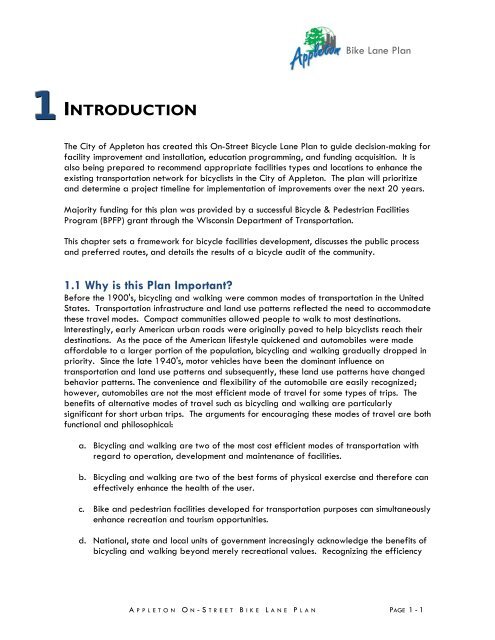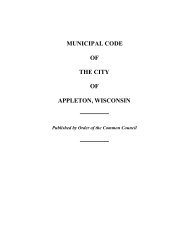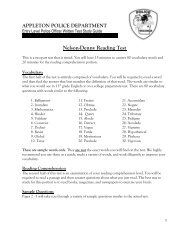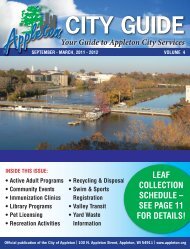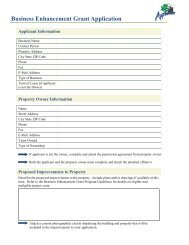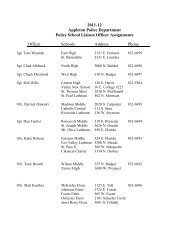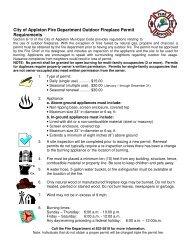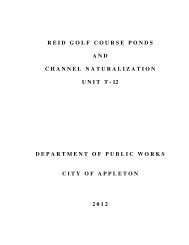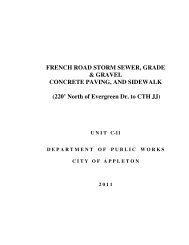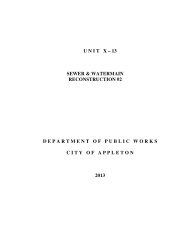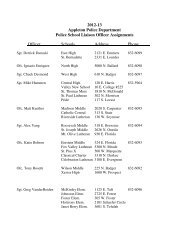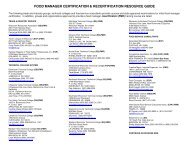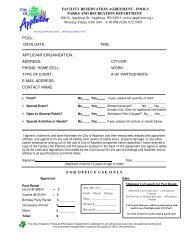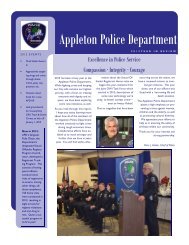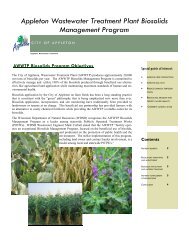City of Appleton On-Street Bike Lane Plan
City of Appleton On-Street Bike Lane Plan
City of Appleton On-Street Bike Lane Plan
You also want an ePaper? Increase the reach of your titles
YUMPU automatically turns print PDFs into web optimized ePapers that Google loves.
1<br />
INTRODUCTION<br />
<strong>Bike</strong> <strong>Lane</strong> <strong>Plan</strong><br />
The <strong>City</strong> <strong>of</strong> <strong>Appleton</strong> has created this <strong>On</strong>-<strong>Street</strong> Bicycle <strong>Lane</strong> <strong>Plan</strong> to guide decision-making for<br />
facility improvement and installation, education programming, and funding acquisition. It is<br />
also being prepared to recommend appropriate facilities types and locations to enhance the<br />
existing transportation network for bicyclists in the <strong>City</strong> <strong>of</strong> <strong>Appleton</strong>. The plan will prioritize<br />
and determine a project timeline for implementation <strong>of</strong> improvements over the next 20 years.<br />
Majority funding for this plan was provided by a successful Bicycle & Pedestrian Facilities<br />
Program (BPFP) grant through the Wisconsin Department <strong>of</strong> Transportation.<br />
This chapter sets a framework for bicycle facilities development, discusses the public process<br />
and preferred routes, and details the results <strong>of</strong> a bicycle audit <strong>of</strong> the community.<br />
1.1 Why is this <strong>Plan</strong> Important?<br />
Before the 1900's, bicycling and walking were common modes <strong>of</strong> transportation in the United<br />
States. Transportation infrastructure and land use patterns reflected the need to accommodate<br />
these travel modes. Compact communities allowed people to walk to most destinations.<br />
Interestingly, early American urban roads were originally paved to help bicyclists reach their<br />
destinations. As the pace <strong>of</strong> the American lifestyle quickened and automobiles were made<br />
affordable to a larger portion <strong>of</strong> the population, bicycling and walking gradually dropped in<br />
priority. Since the late 1940's, motor vehicles have been the dominant influence on<br />
transportation and land use patterns and subsequently, these land use patterns have changed<br />
behavior patterns. The convenience and flexibility <strong>of</strong> the automobile are easily recognized;<br />
however, automobiles are not the most efficient mode <strong>of</strong> travel for some types <strong>of</strong> trips. The<br />
benefits <strong>of</strong> alternative modes <strong>of</strong> travel such as bicycling and walking are particularly<br />
significant for short urban trips. The arguments for encouraging these modes <strong>of</strong> travel are both<br />
functional and philosophical:<br />
a. Bicycling and walking are two <strong>of</strong> the most cost efficient modes <strong>of</strong> transportation with<br />
regard to operation, development and maintenance <strong>of</strong> facilities.<br />
b. Bicycling and walking are two <strong>of</strong> the best forms <strong>of</strong> physical exercise and therefore can<br />
effectively enhance the health <strong>of</strong> the user.<br />
c. <strong>Bike</strong> and pedestrian facilities developed for transportation purposes can simultaneously<br />
enhance recreation and tourism opportunities.<br />
d. National, state and local units <strong>of</strong> government increasingly acknowledge the benefits <strong>of</strong><br />
bicycling and walking beyond merely recreational values. Recognizing the efficiency<br />
A PPLETON O N -STREET B IKE L ANE P LAN PAGE 1 - 1


